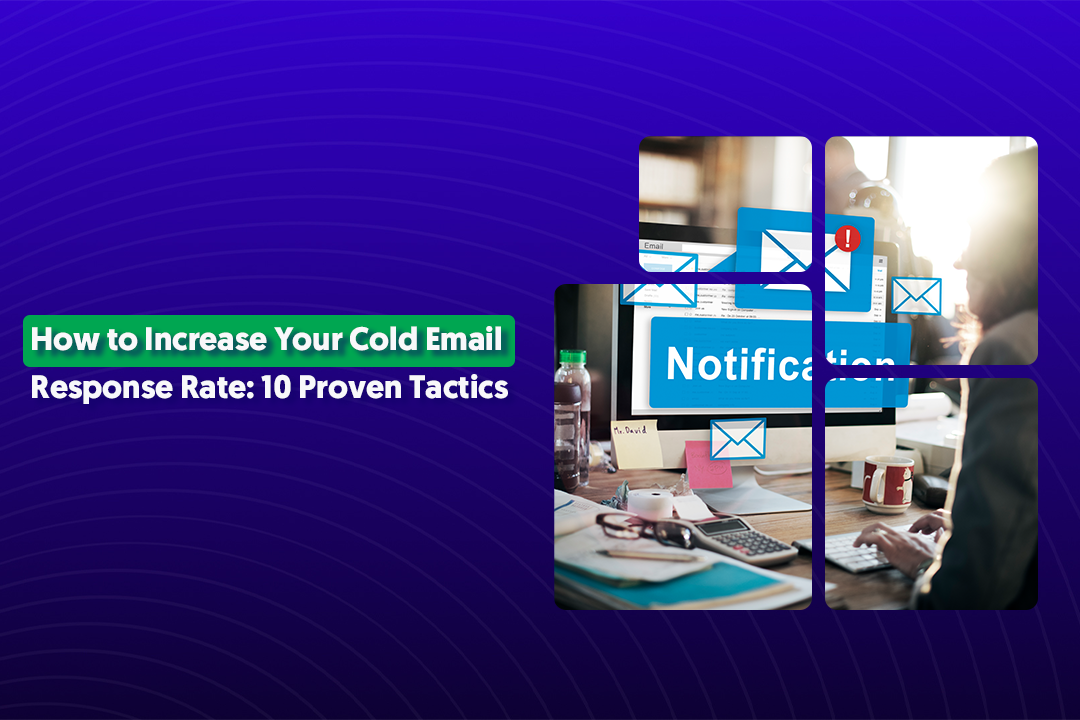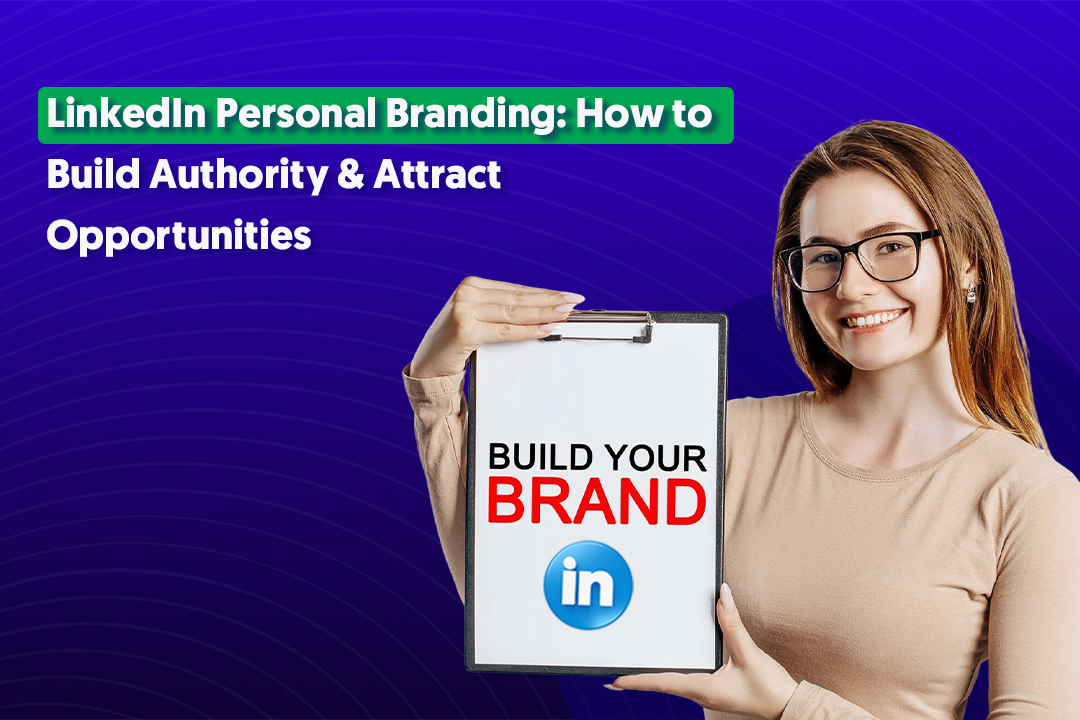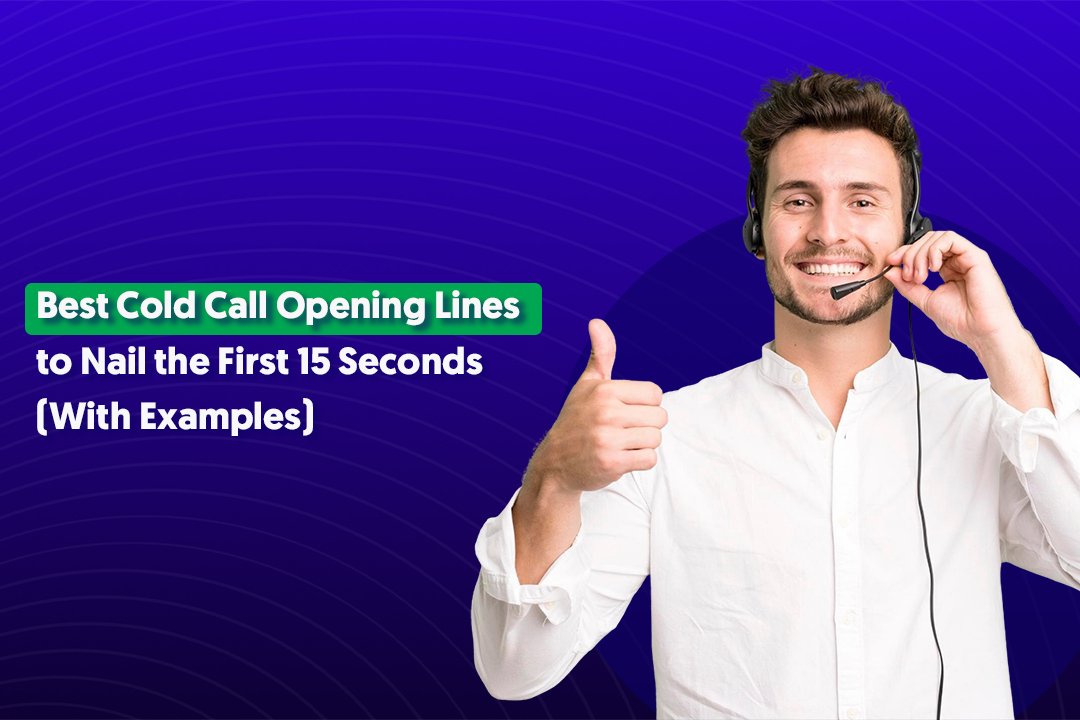Table of Content
Key Takeaways
- LinkedIn organic outreach costs significantly less than paid ads, making it ideal for companies with limited marketing budgets.
- Paid advertising delivers immediate results but requires $30,000+ monthly budgets for meaningful B2B impact.
- Organic strategies build stronger relationships and generate higher-quality leads through trust development.
- Paid ads excel for time-sensitive campaigns like product launches and event promotion.
- ROI depends on your business stage - organic for early-stage companies, paid for established businesses with proven budgets.
- Hybrid approaches often work best - combining organic relationship building with strategic paid campaign deployment for maximum impact.
Ever stared at your LinkedIn ad dashboard watching thousands of dollars disappear with little to show for it?
Or spent countless hours crafting personalized messages that seem to vanish into the LinkedIn void without a single response?
You're not alone.
LinkedIn paid vs organic is the million-dollar question keeping B2B marketers awake at night.
The truth is, most companies get this decision wrong because they don't understand when each approach actually delivers better ROI.
Some burn through $30,000 monthly ad budgets chasing vanity metrics, while others grind away at LinkedIn organic outreach without a strategic framework, wondering why their inbox stays empty.
In this comprehensive comparison, we'll settle the LinkedIn paid vs organic debate once and for all.
You'll discover exactly when LinkedIn ads make financial sense, when organic outreach delivers superior results, and how to choose the strategy that maximizes your marketing ROI without breaking the bank!
Why ROI Matters in B2B LinkedIn Marketing
When evaluating LinkedIn paid vs organic strategies, understanding return on investment goes far beyond simple cost calculations.
Unlike B2C marketing where brand awareness might suffice, B2B LinkedIn campaigns must demonstrate measurable business outcomes.
Every dollar spent or hour invested should contribute to qualified leads, meaningful conversations, and closed deals.
Key ROI considerations for B2B LinkedIn marketing
- Cost per acquisition varies dramatically
- Time investment differs significantly
- Scalability factors impact long-term value
LinkedIn advertising has become increasingly competitive, with cost-per-click rates rising 15-20% year-over-year across most B2B industries.
This trend forces companies to evaluate whether their marketing budgets can sustain LinkedIn paid ads at current price points, or if LinkedIn organic strategies provide better value.
The fundamental difference lies in cost models: LinkedIn paid ads exchange money for immediate speed and scale, while LinkedIn organic outreach trades time and expertise for trust-building and long-term relationship development.
Neither approach is inherently superior - the best choice depends on your budget constraints, timeline expectations, and overall go-to-market strategy.
Understanding this LinkedIn paid vs organic dynamic becomes essential for making informed decisions about where to allocate your LinkedIn marketing resources for maximum ROI.
What Are LinkedIn Paid Ads?
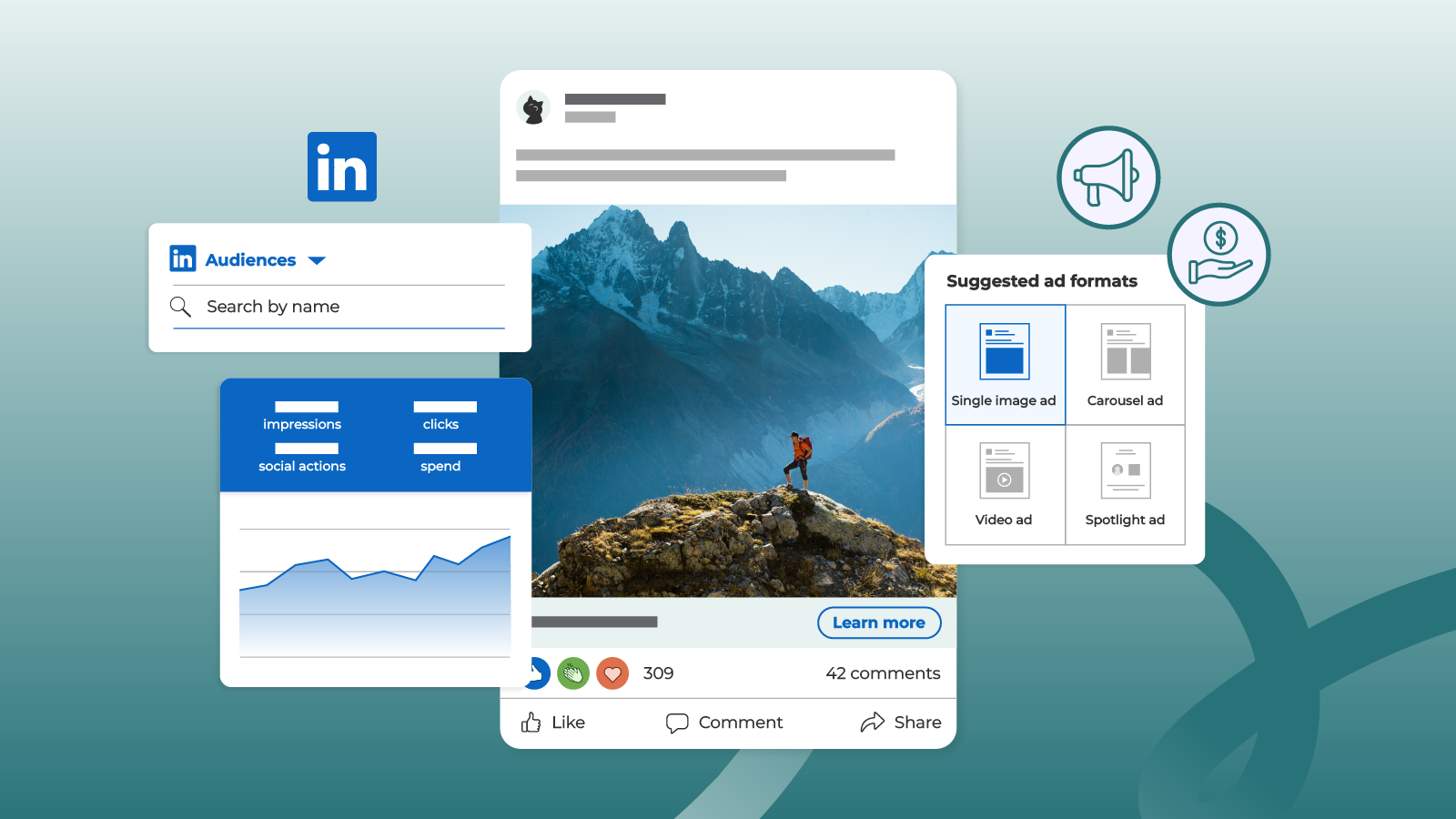
LinkedIn paid ads are promotional content that businesses pay to display across LinkedIn's platform, appearing in users' feeds, inboxes, and sidebar placements.
These ads integrate seamlessly with organic content but carry "Promoted" or "Sponsored" labels to distinguish them from regular posts.
Types of LinkedIn paid advertising formats
- Sponsored Content - Native ads that appear directly in the LinkedIn feed, mimicking organic posts but with enhanced targeting and guaranteed reach.
- Message Ads - Direct messages sent to targeted users' LinkedIn inboxes, allowing personalized outreach at scale.
- Text Ads - Small banner advertisements displayed in the right sidebar of LinkedIn pages.
- Dynamic Ads - Personalized advertisements that automatically include the viewer's profile information.
- Event Ads - Promotional content specifically designed to drive event registrations and attendance.

The platform's targeting capabilities set LinkedIn paid ads apart from other social media advertising.
You can precisely target prospects based on job titles, company size, industry, seniority level, skills, and even specific companies.
Budget control remains flexible, allowing daily spending limits and bid adjustments based on performance metrics.
Advantages of LinkedIn paid advertising
- Instant visibility among your exact target audience without waiting for organic growth
- Scalable testing capabilities to quickly identify winning messages and audiences
- Detailed analytics providing insights into campaign performance and audience behavior
- Professional context where business decision-makers are actively engaging with industry content
Limitations to consider
- High costs - LinkedIn maintains premium pricing with average CPCs ranging $5-15+ depending on industry competition
- Optimization requirements - Campaigns demand continuous monitoring, A/B testing, and refinement to maintain profitability
- Ad fatigue potential - Audiences become less responsive to repeated messaging, requiring fresh creative content
- Budget dependencies - Sustained results require consistent monthly ad spend, typically $5,000+ for meaningful B2B impact
When evaluating paid vs organic approaches, LinkedIn paid ads excel at delivering immediate results and testing market response, but require substantial ongoing investment to maintain momentum.
This makes them ideal for companies with established marketing budgets seeking rapid lead generation, while potentially overwhelming businesses with limited advertising experience or constrained cash flow.
What Is LinkedIn Organic Outreach?
LinkedIn organic outreach encompasses all unpaid activities designed to build relationships, generate leads, and establish thought leadership through authentic engagement on the platform.
Unlike paid advertising, organic strategies rely on personal profiles, valuable content creation, and genuine relationship-building rather than monetary investment.
Core components of LinkedIn organic outreach
- Personal content posting - Sharing industry insights, case studies, and thought leadership content from individual profiles to build authority and attract prospects
- LinkedIn Profile optimization - Crafting compelling headlines, summaries, and experience sections that convert profile visitors into connection requests or inbound inquiries
- Direct message outreach - Personalized connection requests and follow-up messages sent manually to ideal customer profiles without advertising spend
- Strategic engagement - Commenting meaningfully on prospects' posts, sharing their content, and participating in industry discussions to build visibility and rapport
LinkedIn organic strategies require significant time investment rather than monetary cost, with most successful campaigns demanding 1-2 hours daily of consistent activity across multiple touchpoints.
Advantages of organic LinkedIn marketing
- Enhanced credibility - Personal interactions and valuable content build trust more effectively than obvious advertising messages.
- Human-first approach - Direct conversations between real people create stronger business relationships than automated ad targeting.
- Compound returns - Each connection, piece of content, and engagement builds upon previous efforts, creating exponential growth over time.
- Cost efficiency - Beyond time investment, organic outreach requires minimal financial resources compared to paid advertising budgets.
- Algorithm independence - While algorithms affect reach, organic strategies don't rely solely on paid distribution to connect with prospects.
Challenges with LinkedIn organic outreach
- Time-intensive requirements - Building meaningful organic presence demands consistent daily effort over months rather than immediate activation
- Algorithm dependencies - LinkedIn's feed algorithm determines organic content reach, which can fluctuate without warning or control
- Slower initial results - LinkedIn organic vs paid comparisons show organic strategies typically require 3-6 months to generate substantial lead flow
- Scalability limitations - Manual outreach and personal content creation have natural capacity constraints compared to unlimited ad spending.
When comparing linkedin organic vs paid strategies, organic outreach excels at creating lasting business relationships and establishing personal brand authority, while requiring patience and consistent effort rather than substantial advertising budgets.
This makes organic approaches particularly attractive for companies seeking sustainable lead generation without the ongoing costs associated with paid advertising campaigns.
LinkedIn Paid vs Organic: Side-by-Side Comparison

Time vs Budget Investment
- Paid advertising requires substantial monthly marketing spend ($5,000-$30,000+ for meaningful B2B impact) but minimal internal time.
- Organic outreach demands consistent daily time investment (1-2 hours) but minimal financial cost.
- Hidden costs of paid ads include creative development, landing page optimization, and ongoing A/B testing requirements that can add 20-30% to advertising budgets.
- Hidden costs of organic outreach involve personal branding development, content creation, and relationship management that require skilled team members or training investments.
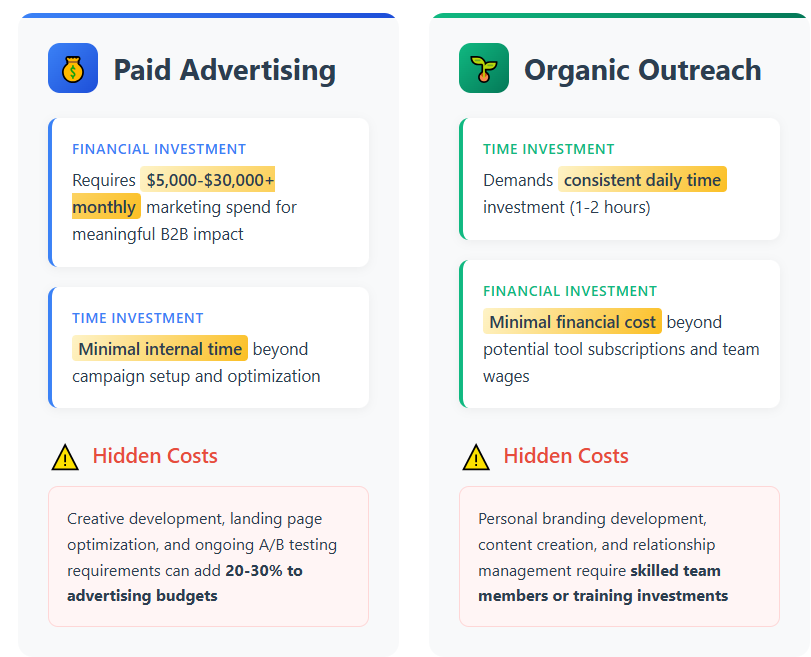
Conversion Potential Differences
- Paid ads typically capture broader, top-funnel leads who may not be ready for sales conversations, resulting in longer nurturing cycles and lower immediate conversion rates.
- Organic outreach builds trust before the pitch, creating higher-intent prospects who are more likely to book calls and convert to customers.
- Trust-building advantage of organic methods means prospects often arrive at sales conversations already familiar with your expertise and approach.
- Paid lead quality can improve with sophisticated targeting and retargeting campaigns, but still lacks the personal relationship foundation of organic connections .
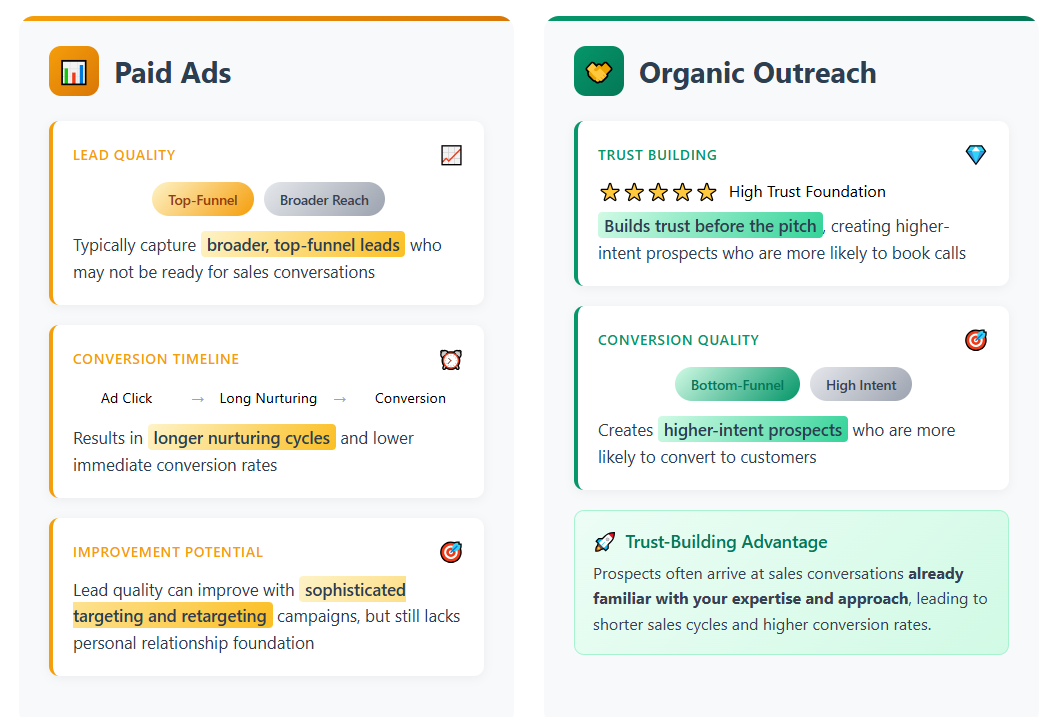
Speed of Results
- Paid advertising delivers immediate traffic and lead generation within 24-48 hours of campaign launch, making it ideal for urgent pipeline needs.
- Organic strategies require 3-6 months to build meaningful momentum, with most successful campaigns showing consistent results after 90 days of daily activity.
- Paid campaign optimization can accelerate results further, with winning combinations identified within 2-4 weeks of testing.
- Organic compound growth creates exponential returns over time, with established profiles generating leads without daily effort after 6-12 months.
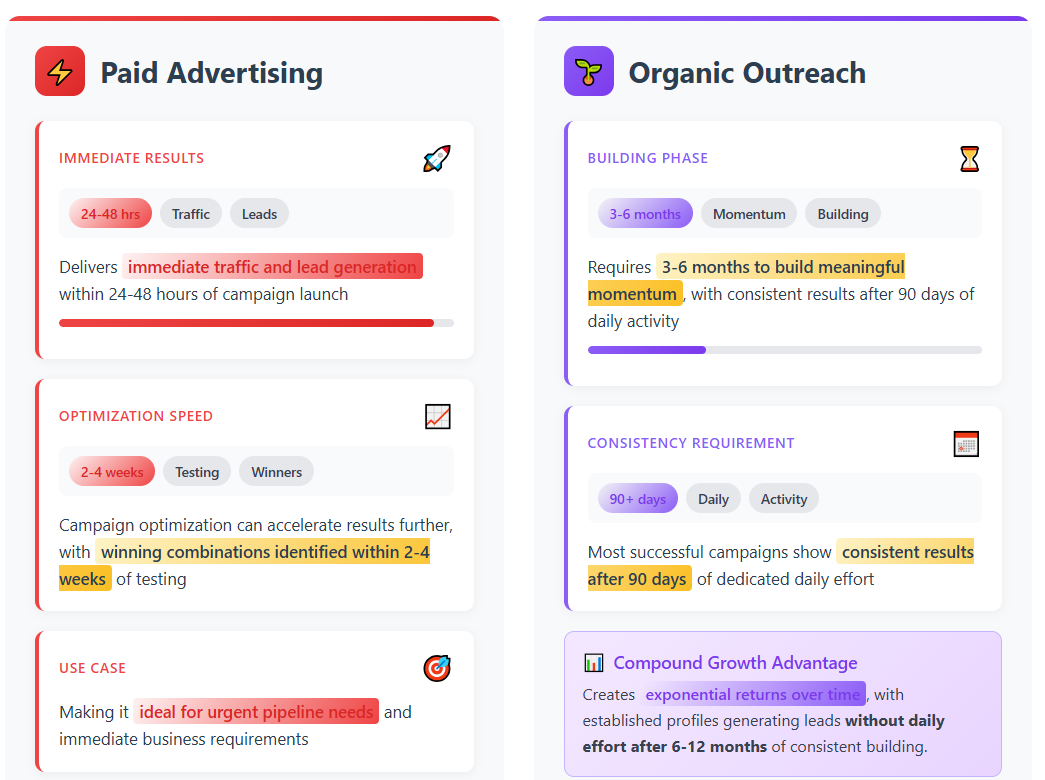
Scalability
- Paid campaigns scale easily with increased budget allocation, allowing rapid expansion into new markets, audiences, or campaign types without capacity constraints.
- Organic outreach faces natural scalability limits due to personal capacity for relationship building and content creation, typically maxing out at 50-100 meaningful connections per week.
- Paid scalability costs increase proportionally with growth, requiring larger budgets to maintain performance as competition intensifies.
- Organic scaling strategies involve team expansion or automation tools, but risk losing the personal touch that makes organic outreach effective.

Trust & Credibility
- Organic content and engagement build significantly more trust and authority than paid advertisements, as audiences perceive personal interactions as more authentic and valuable
- Paid ads carry inherent skepticism from viewers who recognize promotional content, requiring stronger value propositions to overcome advertising resistance
- Thought leadership development through organic content positions individuals as industry experts, creating inbound opportunities that paid ads cannot replicate
- Relationship-based selling through organic methods generates higher customer lifetime value and referral rates compared to paid acquisition

Analytics & Tracking
- Paid advertising provides comprehensive analytics dashboards through LinkedIn's Campaign Manager, offering detailed metrics on impressions, clicks, conversions, and audience insights
- Organic tracking requires manual effort or third-party tools like Shield Analytics, Taplio, or LinkedIn Sales Navigator to measure engagement, connection rates, and outreach performance
- Paid campaign attribution clearly connects ad spend to lead generation and revenue, making ROI calculations straightforward for marketing teams
- Organic measurement challenges include tracking relationship development, content impact, and long-term brand building that may not immediately translate to measurable conversions
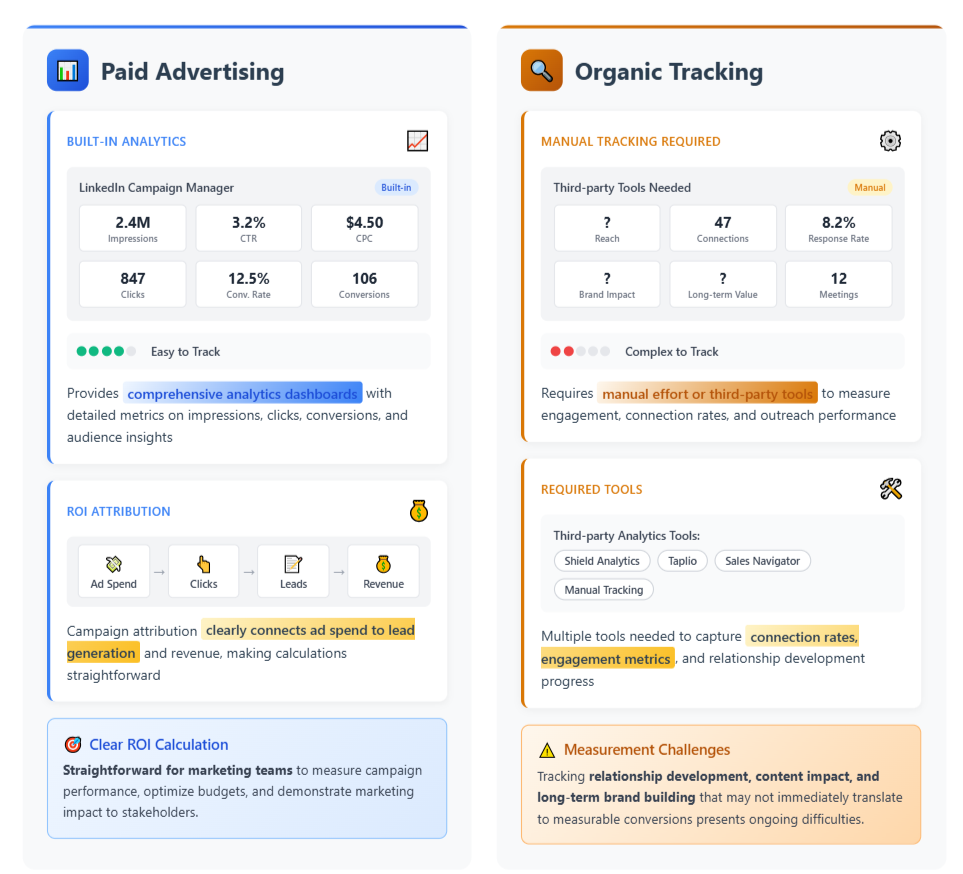
When to Use Paid Ads on LinkedIn
Understanding when to deploy paid LinkedIn strategies versus organic approaches can dramatically impact your marketing ROI and business outcomes.
Ideal use cases for LinkedIn paid advertising:
- Product launches requiring immediate market awareness - New software releases, service offerings, or company announcements benefit from guaranteed visibility among target audiences within hours of campaign activation
- Time-sensitive event promotion - Webinar registrations, conference attendance, and product demonstrations need rapid audience reach that organic content cannot guarantee within tight deadlines
- Gated lead magnet distribution - White papers, industry reports, and exclusive content pieces generate maximum downloads when promoted through targeted sponsored content to relevant professional audiences
- Account-based marketing campaigns - Targeting specific companies or decision-makers with personalized messaging scales effectively through LinkedIn's precise targeting capabilities
LinkedIn paid ads work best for established B2B companies with clearly defined ideal customer profiles and marketing budgets exceeding $5,000 monthly.
Organizations struggling to identify their target audience or lacking budget consistency should prioritize organic strategies first.
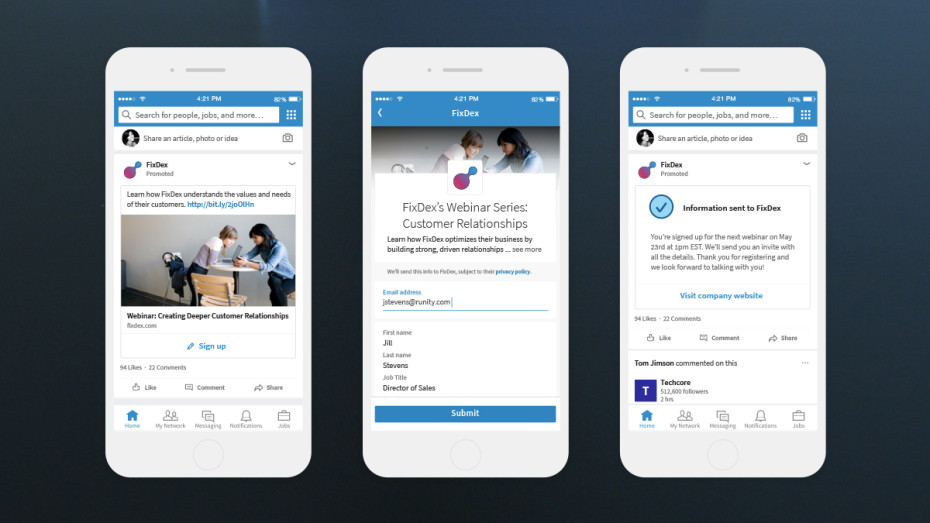
Speed, reach, and volume priorities make paid advertising essential when
- Sales teams need immediate pipeline fill - Quarterly targets or seasonal business cycles require predictable lead flow that organic methods cannot guarantee within required timeframes
- Market testing demands rapid feedback - New messaging, positioning, or product-market fit validation benefits from paid campaign data collection across diverse audience segments
- Competitive landscape requires aggressive positioning - Industries with high LinkedIn activity need paid promotion to cut through organic content saturation and reach decision-makers effectively
Retargeting capabilities provide significant advantages for LinkedIn paid vs organic strategies.
Website visitors, email subscribers, and LinkedIn engagement audiences can receive tailored follow-up campaigns that convert warm prospects into sales-ready leads.
This sophisticated nurturing process requires paid advertising infrastructure that organic outreach cannot replicate at scale.
When paid advertising makes strategic sense
- Marketing budgets exceeding $10,000 monthly for meaningful campaign scale
- Time-sensitive business objectives requiring immediate lead flow
- Clearly defined target audiences and proven value propositions
- Sales teams capable of handling increased qualified lead volume
- Advanced tracking and attribution systems for ROI measurement
The paid vs organic decision ultimately depends on your business timeline, budget availability, and growth stage requirements.
When to Prioritize Organic Outreach on LinkedIn
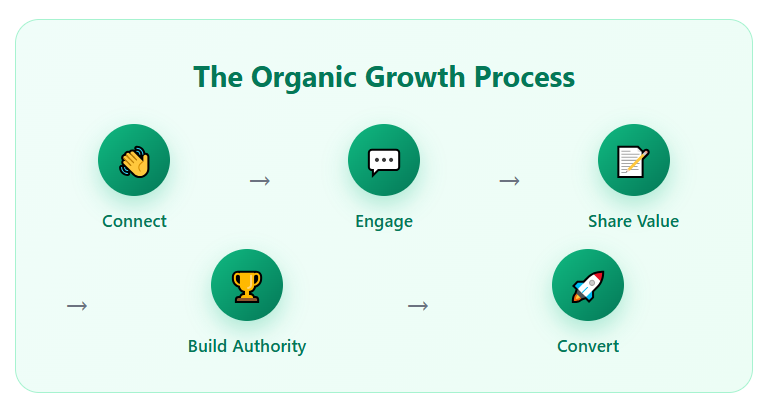
LinkedIn organic strategies become the optimal choice when relationship building, personal branding, and cost efficiency take precedence over immediate lead volume.
Ideal candidates for LinkedIn organic outreach
- Early-stage founders and entrepreneurs who need to establish market credibility and thought leadership before investing significant marketing budgets in paid advertising
- Independent consultants and coaches whose business models depend on personal reputation and direct client relationships that paid advertising cannot authentically replicate
- Sales professionals and business development teams who excel at relationship building and can dedicate consistent time to prospect research, personalized outreach, and follow-up conversations
- Service-based businesses where trust and expertise demonstration matter more than immediate lead volume, particularly in professional services, legal, and financial sectors
Personal brand building and thought leadership development represent LinkedIn organic strategy strengths that paid advertising cannot match.
Budget constraints make organic strategies essential when
- Marketing budgets fall below $5,000 monthly - Insufficient funding for meaningful paid campaign scale makes organic outreach the primary lead generation channel
- Time investment exceeds monetary resources - Teams with available bandwidth but limited advertising budgets can achieve significant results through consistent daily organic activities
- Risk tolerance favors proven relationships over paid advertising experiments that may not generate immediate returns
Long-term relationship building advantages
- Trust development through consistent value delivery - Regular content sharing and engagement builds credibility over months rather than forcing immediate sales conversations
- Compound growth effects - Each meaningful connection, piece of content, and engagement creates exponential returns as network effects multiply opportunities
- Customer lifetime value optimization - Relationships developed through organic outreach typically generate higher contract values, longer retention rates, and more referrals
- Industry positioning and recognition - Consistent organic presence establishes thought leadership that attracts inbound opportunities and speaking engagements
Making the Right Choice for Your Business
The paid vs organic decision ultimately comes down to resource allocation and business objectives.
If you have a $30,000+ monthly marketing budget, LinkedIn paid ads can deliver immediate results and scalable lead generation that justifies the investment.
However, if you don't want to risk $30,000 monthly on advertising or can't afford $500-$750 per booked sales call, LinkedIn organic outreach provides a cost-effective alternative that builds lasting business relationships while generating qualified leads.

At Cleverly, we've helped 10,000+ clients generate leads with companies like Amazon, Google, Uber, PayPal, Slack, Spotify & more.
That resulted in $312 Million in Pipeline Revenue and $51.2 Million in Closed Revenue through Organic LinkedIn Outreach.
If you're interested in generating qualified B2B leads through LinkedIn, click here for more information.
LinkedIn Paid Ads vs Organic: Frequently Asked Questions
1. What's the difference between LinkedIn paid ads and organic marketing?
LinkedIn paid ads are sponsored content that requires budget investment for guaranteed reach, while LinkedIn organic marketing involves free relationship-building activities like content posting, direct outreach, and engagement. Paid ads deliver immediate visibility but cost $500-$750 per booked call, while organic strategies require time investment but build lasting relationships at minimal cost.
2. Is LinkedIn organic outreach better for B2B leads?
LinkedIn organic outreach typically generates higher-quality B2B leads because it builds trust before pitching. Prospects engaged through organic methods arrive at sales conversations already familiar with your expertise, resulting in higher conversion rates and larger deal sizes compared to paid advertising leads.
3. Are LinkedIn ads worth it in 2025?
LinkedIn ads are worth it if you have $10,000+ monthly marketing budgets and need immediate results. With rising costs and increased competition, linkedin paid vs organic analysis shows paid ads work best for established companies with proven value propositions and substantial advertising experience.
4. How can I track ROI from organic LinkedIn outreach?
Track organic ROI by monitoring connection acceptance rates, response rates to outreach messages, meetings booked, and revenue attributed to LinkedIn relationships. Tools like LinkedIn Sales Navigator, Shield Analytics, or simple CRM tracking help measure organic performance, though it requires more manual effort than paid campaign analytics.
5. Should I invest in both paid and organic LinkedIn strategies?
A hybrid LinkedIn paid vs organic approach works best for companies with adequate budgets and resources. Use organic outreach for relationship building and thought leadership, while deploying paid ads for specific campaigns like product launches or event promotion. Start with organic if budget is limited, then add paid advertising as resources allow.



